Why the peppers turned purple: determine the cause and effectively fight it
Purple spots on the leaves, stem or fruit are a common problem for peppers, caused by a lack of phosphorus, metabolic disorders, or the action of aggressive external factors. If you do not understand the reason for the changes in time and do not start treatment, the vegetable can weaken and die.
The content of the article
Why did the peppers turn purple - possible reasons
Darkening of leaves in nightshade culture can be provoked both by the gardener's mistakes and by the unforeseen influence of external factors, for example, an abrupt change in the weather.
It is worth taking action only after the cause of the color change has been established: haphazard application of fertilizers and preparations is dangerous for the plant.
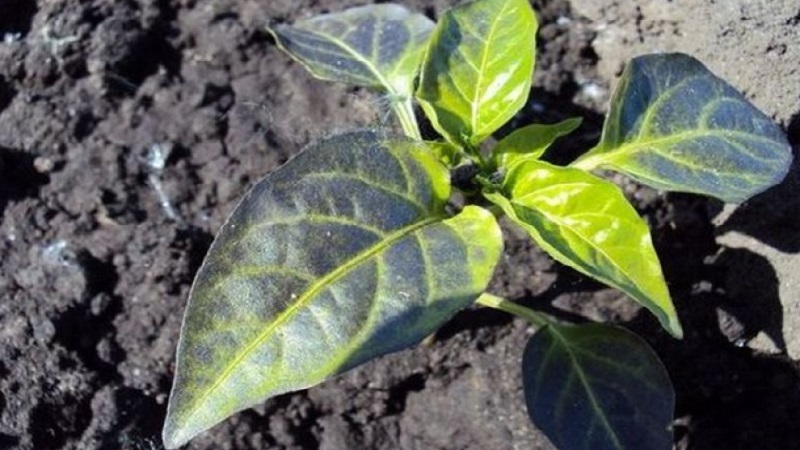
Temperature changes
Most often, the leaves and fruits of peppers acquire a purple hue due to a sharp drop in temperature.... The frozen leaves curl and gradually change color to lilac, and then to dark purple. Darkening, provoked by a sharp cold snap, often occurs due to premature planting in open ground.
Attention! Discoloration of greenhouse peppers can be caused by poor insulation of the greenhouse. Rapid cooling is a serious stress for the plant, therefore it is important to quickly normalize the temperature regime.
Anthocyanosis
Under anthocyonosis understand plant disease caused by phosphorus deficiency in the soil... A trace element is necessary for the growth and development of pepper, and its lack leads to rapid degradation and death of the bush.
The main functions of phosphorus:
- flowering stimulation;
- root development;
- fruit setting;
- regulation of metabolic reactions;
- accumulation of sugar in peppers.
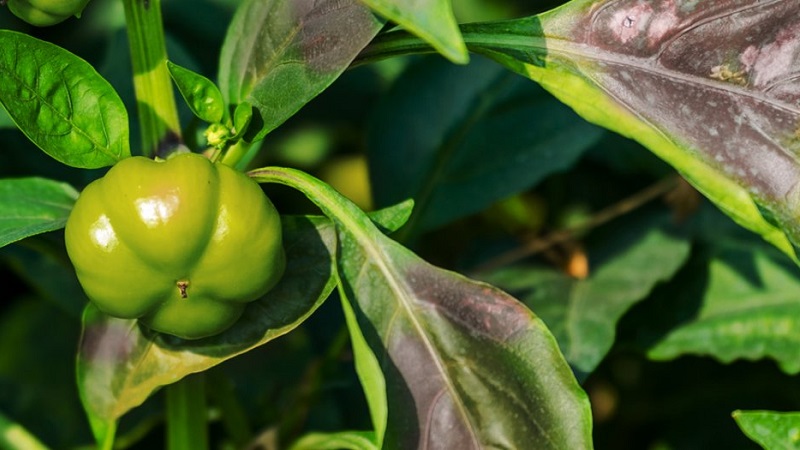
With anthocyanosis, the lower leaves and stem darken first.... The upper ones sometimes retain a green tint. Another symptom is the folding of the leaves inward. With an advanced phosphorus deficiency, the stem will lose its firmness, the roots will weaken and stop absorbing micro- and macroelements from the soil.
It can be useful:
Errors in crop rotation
Another reason for leaf darkening is ignoring crop rotation. You cannot plant seedlings in the same place every season., otherwise the soil will be depleted, the seedlings will no longer receive the necessary nutrients.
When planting peppers at the sites of last year's plantings of other vegetable crops, pay attention to the information from the table:
| Forbidden predecessors | Allowed |
| Pepper | Zucchini |
| A tomato | Carrot |
| Eggplant | Cucumber |
| Potatoes | Onion |
The ban includes vegetables that absorb the same micro and macro elements from the soil.necessary for the development of the pepper. In addition, gardeners need to monitor the herbs growing in the neighborhood: plants from the Solanaceae genus take phosphorus, which is important for pepper, and thereby provoke the appearance of purple spots.
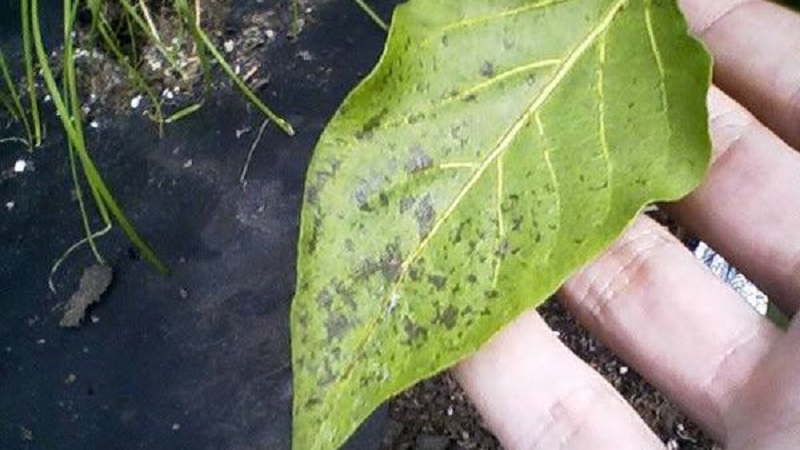
Dryness
Heat, provoking drying out of the soil, negatively affects the root system of plants... Peppers suffering from dehydration cannot absorb and assimilate nutrients in the required amount. Keep in mind that in overdried soil, the content of salts increases, which negatively affects the health of the bush.
Poor soil composition
Not every soil is suitable for growing peppers. If the soil lacks nutrients, then the problem of leaf darkening appears..
Optimal parameters for growing pepperto consider when choosing a site:
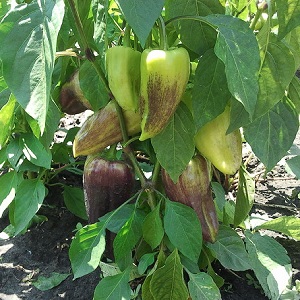 high air permeability;
high air permeability;- the content of potassium, iron, phosphorus and nitrogen;
- high percentage of humus;
- water passage without surface hardening;
- looseness and porosity;
- low soil acidity: the optimal pH is 5-7;
- minimum salt concentration;
- heat supply.
To avoid dark spots, peppers are additionally fertilized with superphosphates.... At the same time, you cannot just scatter fertilizer over the beds, it is diluted in warm water, and then watered at the root.
Why turn purple
Localization of purple spots will help determine the cause of color changes.... The leaves and stem are more likely to darken, less often the fruit itself. At the same time, lilac or dark purple areas on the pepper do not always indicate a plant disease.
Fruit
Purple areas on the skin of the fruit appear due to increased concentration plant matter anthocyanin. Each pepper variety contains this pigment in different amounts. The highest concentration is observed in such varieties:
 Altai Chameleon;
Altai Chameleon;- Purple Star of the East;
- Bagheera;
- The purple bell (pictured).
because purple spots on the fruit may be a feature of the variety... Anthocyanins often manifest themselves under the influence of stress: for example, a sharp drop in temperature, drought, lack of fertilizers.
In this case, the fruit with purple dots can be eaten regardless of the cause of the color defect. Anthocyanins are good for the human body and have a beneficial effect on the functioning of the immune system.
Read also:
Leaves
The reason for the darkening of the leaves is determined by localization of spots:
- change in the color of all leaves - hypothermia;
- lethargy and darkening of the lower leaves of pepper - a lack of micro- and macroelements, feeding is necessary;
- color change in combination with curling leaves, general lethargy signals a lack of moisture;
- a purple stem indicates a lack of nutrients.
It is dangerous to start treatment without knowing the exact cause of the change: high risk of deteriorating the condition of the plant. Therefore, it is necessary not only to inspect the pepper bush, but also to assess the weather conditions, the composition of the soil.
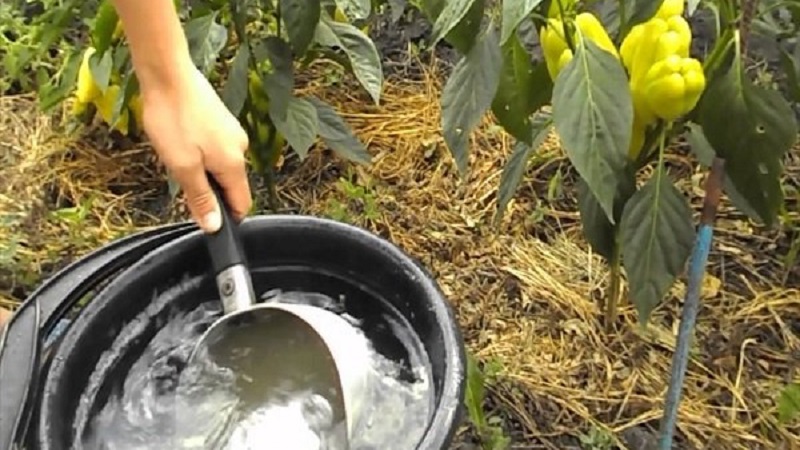
Treatment methods
After establishing the cause of the changes, they proceed to the restoration of the peppers:
- Root dressing... The growing bush is fertilized up to three times a month. Recommended composition: 10 grams of nitrogen, potassium, phosphorus are dissolved in 6-7 liters of water. If the bush is completely covered with purple spots due to strong anthocyanosis, you need to dissolve a glass of superphosphates in boiling water and leave for 10-12 hours. Then the infusion is diluted in a bucket of plain water. One bush will need 1 liter of liquid.
- Spraying with copper sulfate... The procedure is performed once a season. The measure is rather preventive in nature and will not help completely cure the darkened pepper, but it will improve metabolic processes. For spraying, use water at room temperature. One bush takes 1 liter of the mixture.
- Temperature normalization... To adjust the temperature in the greenhouse, special devices are used, airing or heating is carried out with improvised means. To avoid hypothermia, the greenhouse is covered with additional layers of film. You can help peppers outdoors by covering the ground with mulch. The bushes are insulated with special fabric rags.
- Regular watering... Water volumes increase during drought.
It's important not to overdo it when dealing with purple dots.... An excess of phosphorus fertilizers provokes yellowing of foliage, growth retardation and deficiency of such nutrients:
- copper;
- iron;
- magnesium;
- cobalt;
- zinc.
High temperatures can cause burns, therefore it is necessary to warm up the greenhouse gradually, monitoring the reaction of the pepper. It is also necessary to track the temperature of the earth. Optimum performance is + 23-24 ° C.

Preventive measures
Color change can be prevented if you start to act immediately after planting seedlings... Basic rules from experienced gardeners:
- the correct choice of site, accounting for crop rotation;
- constant examination of the bushes, since the earlier darkening is detected, the easier it is to stop the disease;
- surface treatment of growing peppers with a solution of copper sulfate;
- regular watering;
- the use of phosphorus fertilizers.
Pepper requires constant feeding. The first fertilizers are introduced just before planting.... For processing 1 sq. m of soil will be required:
- 8 kg of humus;
- 2 glasses of ash;
- 1 tbsp with a slide of superphosphate;
- 0.75 tbsp. l. sodium sulfate.
The second time feeding is introduced after 18-20 days... You can use the previous composition, but increase the proportion of phosphorus.

Tips & Tricks
Planting seedlings in open soil is carried out only when the temperature reaches + 21 ° C... The optimal period is from early to mid-May. Pepper seeds are recommended to pre-germinate in order to grow the bush faster, but this is an optional step. The most suitable planting depth is 3 mm.
You should choose a bright and warm place. It is impossible to leave the peppers to grow unattended, the bushes require constant formation.
Conclusion
Purple specks on pepper are a signal for gardeners, requiring attention and decisive measures. If at the initial stages the cause of the deviation is determined, the nutrition, water and temperature conditions are normalized, then the bush will quickly return to its previous green color, and the fruits will not suffer.